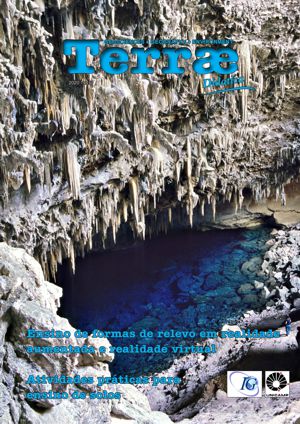Resumo
Este artigo mostra o uso de recursos web para a criação de ambientes de Realidade Virtual (RV) e Realidade Aumentada (RA) para o ensino de conceitos sobre superfícies topográficas. As maquetes virtuais das superfícies construídas com recursos do software Sketchup incluem as representações gráficas de curvas de nível, seções planas e taludes de aterros. As texturas dos terrenos utilizados são fotos de satélite disponibilizadas pela plataforma Digital Globe e contribuem para melhorar a visualização dos conceitos estudados. Os ambientes desenvolvidos possibilitam que os alunos visualizem as superfícies em RA através de seus dispositivos com webcam, tais como smartphones, tablets ou notebooks, observando-as em diversos pontos de vista. Cada superfície topográfica modelada possui um link para sua respectiva representação em RV, que possibilita sua manipulação e estudo detalhado de cada conceito. Os ambientes apresentados neste trabalho podem ser usados em disciplinas de Projeções Cotadas, Topografia e Geografia.
Referências
Abdullah F., Kassim M.H.B., Sanusi N.Z. 2017. Go virtual: exploring augmented reality application in representation of steel architectural construction for the enhancement of architecture education. Advanced Science Letters, 23(2):804-808.
A-frame. 2019. A-frame documentation of Virtual Reality. URL: https://aframe.io/docs/0.8.0/introduction. Accesso 20.05.2019.
Akçayır M., Akçayır G. 2017. Advantages and challenges associ-ated with augmented reality for education: A systematic review of the literature. Educational Research Review, 20:1-11.
Andrade G., Oliveira A.C.C.A., Diniz M.C.A. 2018. Geografia e Sandbox: Contribuições da Realidade Aumentada para o Ensino das Formas de Relevo. In: III Congresso sobre tecnologias na Educação, Proc…, Fortaleza: Cultura Maker, p. 258-270.
Attardi S.M., Rogers K.A. 2015. Design and implementation of an online systemic human anatomy course with laboratory. Anatomical sciences education, 8(1):53-62.
Becker E.L.S., Nunes M.P. 2012. Relevo do Rio Grande do Sul, Brasil, e sua representação em maquete. Revista Percurso, 4(2):113-132.
Cantos L.C., Izquierdo J.L., Cantos E.C. 2016. Interactive multimedia application for teaching and learning in Analytical Geometry. IEEE Latin America Transactions, 14(7):3461-3466.
Carrera C.C., Asensio L.A.B. 2017. Landscape interpretation with augmented reality and maps to improve spatial orientation skill. Journal of Geography in Higher Education, 41(1):119-133.
Cerra P.P., Rodríguez J.G., Álvarez H.F., Parra B.B. 2018. Combining multimedia and self-assessment CAD tools in an interactive web environment to learn engineering drawing. Interactive Learning Environments, 27(2):1-14.
Digital Globe. 2019. Explore geospatial data in context. URL: https://www.digitalglobe.com. Accesso 20.05.2019.
Etienne J. 2017. Efficient Augmented Reality for the Web. URL: https://github.com/jeromeetienne/AR.js. Accesso 20.05.2019.
González N.A.A. 2017. Development of spatial skills with virtual reality and augmented reality. International Journal on Interactive Design and Manufacturing, 12(1):133-144.
Hinrichs T. 2019. An Orbit Controls Component for A-Frame VR. URL: https://github.com/tizzle/aframe-orbit-controls-component. Accesso 20.05.2019.
Huleihil M. 2017. 3D printing technology as innovative tool for math and geometry teaching applications. IOP Conference Series: Materials Science and Engineering, 164(1):1-7.
Irwansyah F.S., Yusuf Y.M., Farida I., Ramdhani M.A. 2018. Augmented Reality (AR) Technology on The Android Operating System in Chemistry Learning. IOP Conference Series: Materials Science and Engineering, 288(1):233-237.
Ishii H. 2010. Augmented Reality: Fundamentals and Nuclear Related Applications. International Journal of Nuclear Safety and simulation, 1(4):316-327.
Kirner C., Kirner T.G. 2011. Development of an interactive artifact for cognitive rehabilitation based on augmented reality. In: International Conference on Virtual Rehabilitation (ICVR’11), Proc…, Zurich: IEEE, p. 1-7.
McMenamin P.G., Quayle M.R., McHenry C.R., Adams J.W. 2014. The production of anatomical teaching resources using three-dimensional (3D) printing technology. Anatomical sciences education, 7(6):479-486.
Moro C., Stromberga Z., Raikos A., Stirling A. 2017. The effectiveness of virtual and augmented reality in health sciences and medical anatomy. Anatomical sciences education, 10(6):549-559.
Munoz-Cristóbal J.A., Gallego-Lema V., Arribas-Cubero H.F. et al. 2018. Game of Blazons: Helping Teachers Conduct Learning Situations That Integrate Web Tools and Multiple Types of Augmented Reality. IEEE Transactions on learning technologies, 11(4):506-519.
Murphy W. 2019. All-in-one natural hand controller, pointer, and gaze interaction library for A-Frame. URL: https://github.com/wmurphyrd/aframe-super-hands-component. Accesso 20.05.2019.
Oliveira J.R. 2018. Visualização de conteúdos multimédia num ambiente de realidade virtual. Porto: Universidade do Porto (Dissertação Mestrado). URL: https://repositorio-aberto.up.pt/bitstream/10216/111492/2/260772.pdf. Acesso 20.05.2019.
Santos E.T., Mafalda R., Kawano, A. et al. 2003. Da geometria cotada ao modelamento 3D: projeto didático. In: XVI Simpósio Nacional de Geometria Descritiva e Desenho Técnico e V International Conference on Graphics Engineering for Arts and Design, Proc…, Santa Cruz do Sul: ABEG, p. 1-7.
Santos R.S., Santos R.S., Alencar C.M.S., Macedo C.M.S. 2018. Realidade Aumentada no Processo de Ensino-Aprendizagem da Topografia em Projeto de Engenharia Civil. In: III Congresso sobre tecnologias na Educação, Proc…, Fortaleza: Cultura Maker, p. 582-589.
Serrano F. 2017. A-Frame teleport controls component. URL: https://git hub.com/fernandojsg/aframe-teleport-controls. Accesso 20.05.2019.
Sketchup. 2019. 3D Design Software. URL: https://www.sketchup.com. Accesso 20.05.2019.
Silva C.M., Ferreira G.C., Arribas-Cubero H.F. et al. 2008. Produção de material didático: jogo das curvas de nível. Boletim Goiano de Geografia, 28:157-170.
Sousa R.R. 2014. Oficina de maquete de relevo: um recurso didático. Terrae Didatica, 10(1):22-28.
Souza W.O., Espíndola, G.M., Pereira, A.R.A., Sá, L.A.C.M. 2016. A realidade aumentada na apresentação de produtos cartográficos. Boletim de Ciências Geodésicas, 22(4):790-806.

Este trabalho está licenciado sob uma licença Creative Commons Attribution-NonCommercial 4.0 International License.
Copyright (c) 2020 Terrae Didatica


